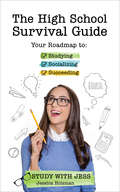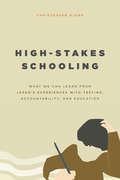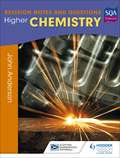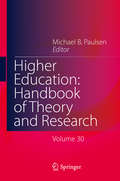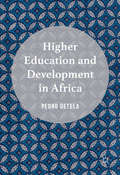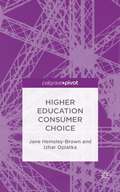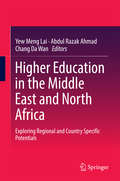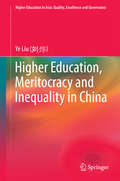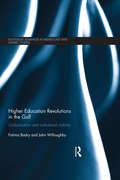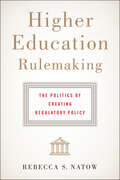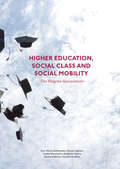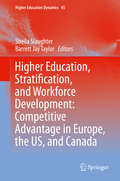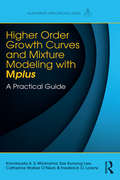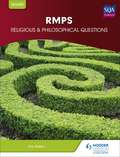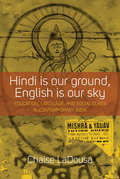- Table View
- List View
The High School Survival Guide: Your Roadmap to Studying, Socializing & Succeeding
by Jessica HolsmanLearn from The High School Survival Guide and be your most organized, productive, motivated, and confident self as you prepare to become a high school freshman. <p><p> A step-by-step guide to high school success. We’re all told to study hard in high school but we’re never taught how. And what about balancing the increasing workload and demands of teenage life? According to Jessica Holman’s step-by-step guide, you don’t have to sacrifice your life to be a high school success. <p> The ultimate graduation book for high school freshmen. You’re a 9th grade or 8th grade graduate and about to enter high school. It’s both exciting and nerve-wrecking. So many students feel anxious, stressed, and overwhelmed at the thought of starting high school. But what if you can love high school, form amazing friendships, grow your self-esteem, and get an excellent education all at the same time? <p> How to study, how to get good grades, and more. High school is all about learning how to learn. In The High School Survival Guide, learn everything from setting up the ideal study space to building confidence and setting effective goals!
High-Stakes Schooling
by Christopher BjorkIf there is one thing that describes the trajectory of American education, it is this: more high-stakes testing. In the United States, the debates surrounding this trajectory can be so fierce that it feels like we are in uncharted waters. As Christopher Bjork reminds us in this study, however, we are not the first to make testing so central to education: Japan has been doing it for decades. Drawing on Japan's experiences with testing, overtesting, and recent reforms to relax educational pressures, he sheds light on the best path forward for US schools. Bjork asks a variety of important questions related to testing and reform: Does testing overburden students? Does it impede innovation and encourage conformity? Can a system anchored by examination be reshaped to nurture creativity and curiosity? How should any reforms be implemented by teachers? Each chapter explores questions like these with careful attention to the actual effects policies have had on schools in Japan and other Asian settings, and each draws direct parallels to issues that US schools currently face. Offering a wake-up call for American education, Bjork ultimately cautions that the accountability-driven practice of standardized testing might very well exacerbate the precise problems it is trying to solve.
Higher Chemistry: Revision Notes and Questions
by David Calder John AndersonThe perfect revision companion to the Higher Chemistry textbook, this newly written resource reflects the very latest SQA curriculum.This book offers bite-sized facts, worked examples and a variety of question types to support and reinforce learning and practice for the final examination.- Dedicated sections on numeracy and researching chemistry- Provides a broad range of questions, including open-ended and past SQA exam questions- Answers section allows students to check their understanding of the standards required for Higher level success
Higher Education: Handbook of Theory and Research
by Michael B. PaulsenPublished annually since 1985, the Handbook series provides a compendium of thorough and integrative literature reviews on a diverse array of topics of interest to the higher education scholarly and policy communities. Each chapter provides a comprehensive review of research findings on a selected topic, critiques the research literature in terms of its conceptual and methodological rigor and sets forth an agenda for future research intended to advance knowledge on the chosen topic. The Handbook focuses on a comprehensive set of central areas of study in higher education that encompasses the salient dimensions of scholarly and policy inquiries undertaken in the international higher education community. Each annual volume contains chapters on such diverse topics as research on college students and faculty, organization and administration, curriculum and instruction, policy, diversity issues, economics and finance, history and philosophy, community colleges, advances in research methodology and more. The series is fortunate to have attracted annual contributions from distinguished scholars throughout the world.
Higher Education and Development in Africa
by Pedro UetelaThis book critically addresses concepts and analyses related to the higher education and development nexus in Africa. The study explores the expansion of higher education in Africa and its impact on development, modernization and the economy to situate Africa within global debates on higher education governance and investment. Using concrete indicators from economic, social and political domains, the book demystifies dominant narratives which giant institutions have applied to disunite the relationship between universities and growth on the continent.
Higher Education Consumer Choice
by Izhar Oplatka Jane Hemsley-BrownHigher Education Consumer Choice provides a comprehensive and highly focused critical analysis of research on HE consumer choice behaviour in the UK and around the world. Ideal for students, scholars and marketing practitioners interested in consumer choice and behaviour in higher education markets, the book explores the background and context to research on HE choice including globalization, changing supply and demand, fees and costs, and concerns about social disadvantage. Focusing on personal factors that influence consumer choice, group aspects of consumer behaviour such as cultural and ethnic differences, as well as theoretical and research models, this book is designed to stimulate new debate and criticism of HE consumer choice.
Higher Education in the Middle East and North Africa
by Chang Wan Abdul Razak Ahmad Yew Meng LaiThis book explores the prospects for higher education development in the Middle East and North African (MENA) region. Adopting a South-South perspective (from the viewpoint of a developing country), it seeks to promote a deeper understanding of this colourful and highly diverse, yet volatile region. As such, it examines six selected MENA countries that serve as case studies for identifying the gaps and challenges as well as their potentials in terms of higher education development. Based on expert interviews and focus-group discussions with more than 85 individuals across the six countries and complemented by related facts and figures from both international and national documents, it presents an in-depth discussion and analysis of the countries' respective political, security, and economic situations. These serve as preconditions for the cultivation of an environment conducive to facilitating the advancement of higher education. It also provides a critical overview of higher education in these countries, notably in terms of the current national system, legislative framework, accreditation, quality assurance, recognition concerns, and other critical issues that enable and/or constrain the development of their respective higher education sectors, and that of the region, as a whole.
Higher Education, Meritocracy and Inequality in China
by Ye LiuThis book investigates the changing opportunities in higher education for different social groups during China's transition from the socialist regime to a market economy. The first part of the book provides a historical and comparative analysis of the development of the idea of meritocracy, since its early origins in China, and in more recent western thought. The second part then explores higher education reforms in China, the part played by supposedly meritocratic forms of selection, and the implications of these for social mobility. Based on original empirical data, Ye Liu sheds light on the socio-economic, gender and geographical inequalities behind the meritocratic fa#65533;ade of the Gaokao (高考). Liu argues that the Chinese philosophical belief in education-based meritocracy had a modern makeover in the Gaokao, and that this ideology induces working-class and rural students to believe in upward social mobility through higher education. When the Gaokao broke the promise of status improvement for rural students, they turned to the Chinese Communist Party and sought political connections by actively applying for its membership. This book reveals a bleak picture of visible and invisible inequality in terms of access to and participation in higher education in contemporary China. Written in an accessible style, it offers a valuable resource for researchers and non-specialist readers alike.
Higher Education Revolutions in the Gulf: Globalization and Institutional Viability (Routledge Advances in Middle East and Islamic Studies)
by John Willoughby Fatima BadryOver the past quarter century, the people of the Arabian Peninsula have witnessed a revolutionary transformation in higher education. In 1990, there were fewer than ten public universities that offered their Arabic-language curricula in sex-segregated settings to national citizens only. In 2015, there are more than one hundred public, semi-public, and private colleges and universities. Most of these institutions are open to expatriates and national citizens; a few offer gender integrated instruction; and the language of instruction is much more likely to be in English than Arabic. Higher Education Revolutions in the Gulf explores the reasons behind this dramatic growth. It examines the causes of the sharp shift in educational practices and analyses how these new systems of higher education are regulated, evaluating the extent to which the new universities and colleges are improving quality. Questioning whether these educational changes can be sustained, the book explores how the new curricula and language policies are aligned with official visions of the future. Written by leading scholars in the field, it draws upon their considerable experiences of teaching and doing research in the Arabian Gulf, as well as their different disciplinary backgrounds (linguistics and economics), to provide a holistic and historically informed account of the emergence and viability of the Arabian Peninsula’s higher education revolutions. Offering a comprehensive, critical assessment of education in the Gulf Arab states, this book represents a significant contribution to the field and will be of interest to students and scholars of Middle East and Gulf Studies, and essential for those focused on higher education.
Higher Education Rulemaking: The Politics of Creating Regulatory Policy
by Rebecca S. NatowAn in-depth look at how federal regulatory policy for higher education is drafted, influenced, and enacted.Many higher education academics and administrators have only vague notions about how the federal government makes regulations governing colleges and universities in the United States, and yet these regulations control many important aspects of the operation of these institutions. What happens after legislation affecting higher education is signed into law? How are specific provisions implemented—especially when the statute’s details are unclear? And who determines the details of the programs that a particular law has authorized? In this concise and informative book, higher education policy expert Rebecca S. Natow explores the how and why of the federal regulatory policymaking process as it pertains to higher education, financial aid, and student loan debt. Drawing on in-depth interviews with policy and higher education actors, as well as an extensive review of specific regulations and documents, Natow explains who influences higher education rulemaking and how their beliefs and surrounding contexts guide the policies they enact. She also examines the strategies and powers employed during the process, reveals how technology affects the creation of higher education rules, delves into the multifaceted implications of regulation for students and institutions, and discusses future prospects for higher education rulemaking.The first comprehensive, research-based account of this important policymaking process, Higher Education Rulemaking will serve as a valuable resource for scholars, researchers, policymakers, and higher education professionals.
Higher Education, Social Class and Social Mobility
by Ann-Marie Bathmaker Nicola Ingram Jessie Abrahams Anthony Hoare Richard Waller Harriet BradleyThis book explores higher education, social class and social mobility from the point of view of those most intimately involved: the undergraduate students. It is based on a project which followed a cohort of young undergraduate students at Bristol's two universities in the UK through from their first year of study for the following three years, when most of them were about to enter the labour market or further study. The students were paired by university, by subject of study and by class background, so that the fortunes of middle-class and working-class students could be compared. Narrative data gathered over three years are located in the context of a hierarchical and stratified higher education system, in order to consider the potential of higher education as a vehicle of social mobility.
Higher Education, Stratification, and Workforce Development
by Sheila Slaughter Barrett Jay TaylorThis work analyses how political economic shifts contribute to competition within higher education systems in the US, EU, and Canada. The authors highlight competition for prestige and public and private subsidies, exploring the consequences of these processes through theoretical and empirical analyses. Accordingly, the work highlights topics that will be of interest to a wide range of audiences. Concepts addressed include stratification, privatization of formerly public subsidies, preference for "high tech" academic fields, and the vocationalization of the curriculum (i. e. , Science, Technology, Engineering and Mathematics: [STEM] fields, selected professions, and business) rather than the liberal arts or the Humboldtian vision of the university. Across national contexts and analytic methods, authors analyze the growth of national policies that see universities as a sub set of economic development, casting universities as corporate research laboratories and education as central to job creation. Throughout the volume, the authors make the case that national and regional approaches to politics and markets result in different experiences of consequences of academic capitalism. While these shifts serve the interests of some institutions, others find themselves struggling to meet ever-greater expectations with stagnant or shrinking resource bases.
Higher-Order Growth Curves and Mixture Modeling with Mplus: A Practical Guide (Multivariate Applications Series)
by Kandauda K.A.S. Wickrama Tae Kyoung Lee Catherine Walker O’Neal Frederick O. LorenzThis practical introduction to second-order and growth mixture models using Mplus introduces simple and complex techniques through incremental steps. The authors extend latent growth curves to second-order growth curve and mixture models and then combine the two. To maximize understanding, each model is presented with basic structural equations, figures with associated syntax that highlight what the statistics mean, Mplus applications, and an interpretation of results. Examples from a variety of disciplines demonstrate the use of the models and exercises allow readers to test their understanding of the techniques. A comprehensive introduction to confirmatory factor analysis, latent growth curve modeling, and growth mixture modeling is provided so the book can be used by readers of various skill levels. The book’s datasets are available on the web. Highlights include: -Illustrative examples using Mplus 7.4 include conceptual figures, Mplus program syntax, and an interpretation of results to show readers how to carry out the analyses with actual data. -Exercises with an answer key allow readers to practice the skills they learn. -Applications to a variety of disciplines appeal to those in the behavioral, social, political, educational, occupational, business, and health sciences. -Data files for all the illustrative examples and exercises at www.routledge.com/9781138925151 allow readers to test their understanding of the concepts. -Point to Remember boxes aid in reader comprehension or provide in-depth discussions of key statistical or theoretical concepts. Part 1 introduces basic structural equation modeling (SEM) as well as first- and second-order growth curve modeling. The book opens with the basic concepts from SEM, possible extensions of conventional growth curve models, and the data and measures used throughout the book. The subsequent chapters in part 1 explain the extensions. Chapter 2 introduces conventional modeling of multidimensional panel data, including confirmatory factor analysis (CFA) and growth curve modeling, and its limitations. The logical and theoretical extension of a CFA to a second-order growth curve, known as curve-of-factors model (CFM), are explained in Chapter 3. Chapter 4 illustrates the estimation and interpretation of unconditional and conditional CFMs. Chapter 5 presents the logical and theoretical extension of a parallel process model to a second-order growth curve, known as factor-of-curves model (FCM). Chapter 6 illustrates the estimation and interpretation of unconditional and conditional FCMs. Part 2 reviews growth mixture modeling including unconditional growth mixture modeling (Ch. 7) and conditional growth mixture models (Ch. 8). How to extend second-order growth curves (curve-of-factors and factor-of-curves models) to growth mixture models is highlighted in Chapter 9. Ideal as a supplement for use in graduate courses on (advanced) structural equation, multilevel, longitudinal, or latent variable modeling, latent growth curve and mixture modeling, factor analysis, multivariate statistics, or advanced quantitative techniques (methods) taught in psychology, human development and family studies, business, education, health, and social sciences, this book’s practical approach also appeals to researchers. Prerequisites include a basic knowledge of intermediate statistics and structural equation modeling.
Higher RMPS: Religious & Philosophical Questions
by Joe WalkerThe only resource for religious and philosophical questions at Higher level, by a bestselling author and expert in the field.Joe Walker's new full colour book provides comprehensive coverage of the newly designed CFE Higher in Religious, Moral and Philosophical Studies, but is also ideal for students across Scotland studying key topic areas in Religious and Philosophical Questions as part of the broad general education and the senior phase of RME. The book:Offers a lively, accessible and engaging style with appropriate humour that reflects real-life situations and moral issuesHighlights the importance of dealing with varieties of belief within religious traditionsDeals with up-to-date contemporary and topical issues in a highly practical manner
Hindi class 10 - GSTB: हिंदी कक्षा 10 - जीएसटीबी
by Gstbપ્રસ્તુત પાઠ્યપુસ્તક ધોરણ 10 ના હિન્દી વિષય નું પાઠ્યપુસ્તક છે જેમાં ૨૩ પાઠ આપેલ છે.
Hindi class 11 - GSTB: हिन्दी कक्षा 11 - जीएसटीबी
by Gstbઆ પુસ્તક ધોરણ 11 નું હિન્દી વિષય નું પાઠ્યપુસ્તક છે .
Hindi class 11 - GSTB: हिंदी कक्षा 11 - जीएसटीबी
by Gstbसाधो, देखो जग बौराना प्रस्तुत पद में कबीर ने अपने युग में व्याप्त हिन्दू-मुस्लिम धर्म की विसंगतियों तथा अन्तर्विरोधों, धार्मिक संकीर्णताओं, बह्यांडम्बरो आदि का खुलकर विरोध करते हुए धर्म के ठेकेदारों को आत्मज्ञान प्राप्ति की नसीहत दे रहे हैं | बापू की कुटिया में प्रस्तुत पाठ ‘बापू की कुतिया’ में लेखक को गांधीजी के जीवन-काल में उनसे न मिल पाने का रंज है तो दूसरी और उनकी अनुपस्थिति में कुटिया की हर वस्तु को आत्मसात करने का सुअवसर पाकर अपने आप को भाग्यशाली मानते हैं पुरानी चीजों के पक्ष में | प्रस्तुत कविता में सच के साथ मनुष्यता को बचाये रखने के लिए निरंतर संघर्ष करता मिलता है | चन्द्रशेखर आज़ाद प्रस्तुत संस्मरण में लेखक ने चन्द्रशेखर आज़ाद से जुडी हुई स्मृतियों के माध्यम से उनके जीवन व्यक्तित्व तथा उनकी निडरता पर ट्टष्टिपाट किया है शिक्षक के नाम पत्र यह पत्र अमेरिका के राष्ट्रपति अब्राहम लिंकन ने अपने पुत्र के अध्यापक को लिखा है- जिसमें अध्यापक के द्रारा किसी विधार्थी को ईमानदारी, विवेकशील, परिकश्रमी, धैर्यवान, आत्मनिर्भर बनाने के साथ-साथ अपने विचार स्वयं बनाने पर बल दिया गया है |भारतमाता की जय प्रस्तुत लेख में अनपढ़ ग्रामीण लोग ‘भारतमाता की जय’ का नारा तो लगाते हैं किन्तु भारतमाता के सच्चे स्वरूप तथा उनकी वत्सलता से अनजान हैं |परशुराम – लक्ष्मण संवाद प्रस्तुत अंश ‘रामचरितमानस’ के ‘बालकांड’ से लिया गया है | रामचन्द्र द्रारा शिवजी के धनुष तोड़े जाने पर परशुरामजी के क्रोध का वर्णन है पंचलाइट ‘पंचलाइट’ रेणुजी की गिनीचुनी प्रसिद्ध कहानियाँ में से एक है | पंच के न्याय दंड-जुरमाना, नयी चीज के आनेपर धर्म-ध्यान और कीर्तन के माध्यम से ग्रामजीवन का बखूबी चित्रण हुआ है; गाँव के अनपढ़ लोगों में अज्ञान जातिगत देष को उजागर किया है चंपा काले काले अच्छर नहीं चीन्हती यहाँ संकलित कविता ‘चम्पा काले-काले अच्छर नहीं चीन्हती’ में गाँव की अनपद लड़कियों और सामान्य-जन को नायकत्व प्रदान किया गया है |अजन्ता प्रस्तुत प्रवास वर्णन में अजन्ता की गुफाओं का परिचय मिलता है नीति के दोहे यहाँ ‘नीति के दोहों’ में आचरण की शुद्धता पर बल दिया है | जीवन का सत्य उजागर करनेवाले इन संकलित दोनों में शक्ति की महता, मैत्री, संगति का फल, वाणी का प्रभाव, योग्यता, बड़े-छोटे का भेद दरिद्रता, कृपण, जिहवा की विशेषता, एवं उदारता का मार्मिक चित्रण है | दु:ख, कदम मिलाकर चलना होगा , नन्हा–सा पौधा,बाज़ लोग, कल्पना-शक्ति,गज़ल, पहली चूक,डंका,दो लघु-कथाएँ .वगेरे पाठ भी सुन्दर तरीकेसे प्रस्तुत किये गये है.
Hindi class 5 - RBSE: हिंदी कक्षा 5 - आरबीएसई
by Rajasthan State Textbook BoardHindi Textbook for Class 5
Hindi class 6 - RBSE: हिंदी कक्षा 6 - आरबीएसई
by Rajasthan State Textbook BoardHindi Textbook for Class 6
Hindi class 7 - RBSE: हिंदी कक्षा 7 - आरबीएसई
by Rajasthan State Textbook BoardHindi Textbook for Class 7
Hindi class 8 - RBSE: हिंदी कक्षा 8 - आरबीएसई
by Rajasthan State Textbook BoardHindi Textbook for Class 8
Hindi class 9 - GSTB: हिंदी वर्ग 9 - जीएसटीबी
by Gstbभाषाकीय नये अभ्यासक्रम का एक उदेश्य यह है, कि इस स्तर के छात्र व्यवहारिक भाषा का उपयोग करने के साथ-साथ अपनी भाषा-अभिव्यक्ति को विशेष प्रभावशाली बनाएँ । साहित्यिक स्वरूप एवं सर्जनात्मक भाषा का परिचय के साथ-साथ हिन्दी भाषा की खुबियों को समझकर अपने स्व-लेखन में प्रयोग करना सिखें, इस लिए स्व-लेखन के लिए छात्रों को पूर्ण अवकाश दिया गया है । समझकर अपने स्व-लेखन में प्रयोग करना सिखें, इस लिए स्व-लेखन के लिए छात्रों को पूर्ण अवकाश दिया गया है । इस पाठ्यपुस्तक को रुचिकर, उपयोगी एवं क्षतिरहित बनाने का पूरा प्रयास मंडल द्वारा किया गया है, प्रस्तुत प्रार्थना मे 'सत्यं शिवं सुंदरम्' की भावना के साथ दीन-दुखियों की रक्षा करना, मानवता की उपासना करना, भेदभावों को दूर करना, बैरभाव से मुक्त हो कर विश्वबन्धुत्व की स्थापना करना-जैसे वैश्विक मूल्यों को हस्तान्तरण करने की प्रेरणा देनेवाली यह प्रार्थना मराठी से अनुदित है । प्रस्तुत निबंध में द्विवेदीजी ने यह समझाया है कि तत्कालीन भारतीय समाज में व्याप्त अनाचार केवल बाहरी स्तर पर है ; वास्तव में आज भी लोगो में मानवीय मूल्यो के प्रति आस्था कायम है । अपने जीवन में घटित कुछ घटनाओं के द्वारा बताया है कि हमें निराश नहीं होना चाहिए अपितु हमें जीवन के प्रति आस्थावान बने रहना चाहिए । प्रस्तुत पाठ्यपुस्तक में २४ प्रकरण है पूरक वांचन और स्वाध्याय भी दिये गे है.
Hindi Is Our Ground, English Is Our Sky: Education, Language, and Social Class in Contemporary India
by Chaise LadousaA sea change has occurred in the Indian economy in the last three decades, spurring the desire to learn English. Most scholars and media venues have focused on English exclusively for its ties to processes of globalization and the rise of new employment opportunities. The pursuit of class mobility, however, involves Hindi as much as English in the vast Hindi-Belt of northern India. Schools are institutions on which class mobility depends, and they are divided by Hindi and English in the rubric of "medium," the primary language of pedagogy. This book demonstrates that the school division allows for different visions of what it means to belong to the nation and what is central and peripheral in the nation. It also shows how the language-medium division reverberates unevenly and unequally through the nation, and that schools illustrate the tensions brought on by economic liberalization and middle-class status.
Hindi Language - 3 class 10 - Karnataka Board: हिंदी भाषा - 3 कक्षा 10 - कर्नाटक बोर्ड
by Karnataka Patyapusthaka SanghaHindi Language-3 Textbook for 10th Standard kannada medium Karnataka State
Hindi Language - 3 class 6 - Karnataka Board: हिंदी भाषा - 3 कक्षा 6 - कर्नाटक बोर्ड
by Karnataka Patyapusthaka SanghaHindi language-3 textbook for 6th Standard Kannada medium, Karnataka State
